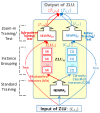Zoom-In Neural Network Deep-Learning Model for Alzheimer's Disease Assessments
- PMID: 36433486
- PMCID: PMC9694235
- DOI: 10.3390/s22228887
Zoom-In Neural Network Deep-Learning Model for Alzheimer's Disease Assessments
Abstract
Deep neural networks have been successfully applied to generate predictive patterns from medical and diagnostic data. This paper presents an approach for assessing persons with Alzheimer's disease (AD) mild cognitive impairment (MCI), compared with normal control (NC) persons, using the zoom-in neural network (ZNN) deep-learning algorithm. ZNN stacks a set of zoom-in learning units (ZLUs) in a feedforward hierarchy without backpropagation. The resting-state fMRI (rs-fMRI) dataset for AD assessments was obtained from the Alzheimer's Disease Neuroimaging Initiative (ADNI). The Automated Anatomical Labeling (AAL-90) atlas, which provides 90 neuroanatomical functional regions, was used to assess and detect the implicated regions in the course of AD. The features of the ZNN are extracted from the 140-time series rs-fMRI voxel values in a region of the brain. ZNN yields the three classification accuracies of AD versus MCI and NC, NC versus AD and MCI, and MCI versus AD and NC of 97.7%, 84.8%, and 72.7%, respectively, with the seven discriminative regions of interest (ROIs) in the AAL-90.
Keywords: AAL functional regions; Alzheimer’s disease; deep neural networks; discriminative regions of interest of Alzheimer’s disease; metacognitive learning; resting-state fMRI.
Conflict of interest statement
The authors declare no conflict of interest.
Figures






References
-
- Sutskever I., Martens J. On the importance of initialization and momentum in deep learning; Proceedings of the 30th International Conference on Machine Learning; JMLR Atlanta, GA, USA. June 2013; pp. 16–21.
-
- Rumelhart D.E., Hinton G.E., Williams R.J. Learning representations by back-propagating errors. Nature. 1986;323:533–536. doi: 10.1038/323533a0. - DOI
-
- Bengio Y. Learning deep architectures for AI. Found. Trends Mach. Learn. 2009;2:1–127. doi: 10.1561/2200000006. - DOI
MeSH terms
Grants and funding
LinkOut - more resources
Full Text Sources
Medical

